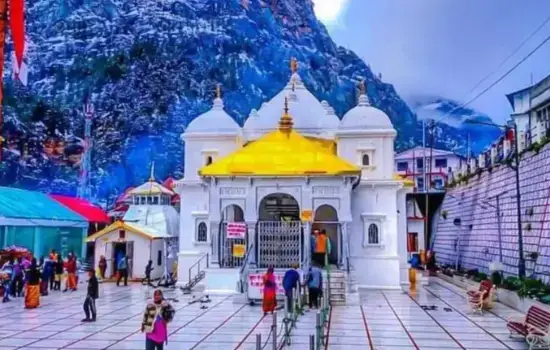Gangotri, one of the four sacred Char Dham pilgrimage sites in Uttarakhand, India, is a serene and spiritually significant destination for devotees and nature enthusiasts alike. Located at an altitude of 3,100 meters in the Garhwal Himalayas, Gangotri is not only the source of the holy River Ganges but also offers breathtaking views of snow-capped mountains, lush valleys, and cascading waterfalls. To make the most of your visit, it’s essential to choose the right time, as Gangotri experiences a range of weather conditions throughout the year.

Gangotri in Summer (April to June)
The summer season, from April to June, is considered the best time to visit Gangotri. During this period, the weather is pleasant with temperatures ranging between 10°C to 20°C, making it ideal for sightseeing and trekking. The temple doors open around late April or early May, marking the start of the pilgrimage season. The lush greenery, blooming flowers, and clear skies provide a perfect backdrop for spiritual activities and exploring the natural beauty of the area. Summer is also the peak season for trekking enthusiasts who embark on the challenging journey to Gaumukh, the glacier that serves as the source of the Ganges.
Gangotri in Monsoon (July to September)
Gangotri experiences heavy rainfall during the monsoon season, from July to September. The region is prone to landslides and roadblocks, making travel risky and challenging. The increased water levels in the river can also make trekking hazardous. However, the rain transforms the landscape into a lush green paradise, and the waterfalls become more vigorous, adding to the scenic beauty of the area. If you plan to visit during the monsoon, it is essential to check weather forecasts and road conditions and to be prepared for possible delays.
Gangotri in Autumn (September to November)
Autumn, from late September to early November, is another great time to visit Gangotri. The rains have subsided, leaving the landscape fresh and rejuvenated. The temperatures during this period range from 5°C to 15°C, making the weather cool and comfortable. The temple remains open during this time, and the crowd is thinner compared to the peak summer season, offering a more peaceful and serene environment for worship and exploration. The clear skies and crisp mountain air enhance the overall experience, making autumn an excellent alternative to the summer months.
Gangotri in Winter (November to March)
Gangotri is not accessible during the winter months, from November to March, due to heavy snowfall and freezing temperatures that can drop below -5°C. The temple is closed during this period, and the idol of Goddess Ganga is moved to Mukhba, a village near Harsil, for worship. Roads leading to Gangotri are often blocked by snow, and the harsh weather conditions make it unsuitable for travel. However, for those interested in experiencing the winter beauty of the Himalayas, nearby destinations like Harsil offer a glimpse of snow-covered landscapes and a tranquil atmosphere.
Conclusion
The best time to visit Gangotri is during the summer months of April to June and the autumn months of September to November. These seasons offer pleasant weather, clear skies, and safe travel conditions, allowing you to fully enjoy the spiritual and natural beauty of this sacred destination. Whether you are visiting for a pilgrimage, trekking, or simply to soak in the serene environment, choosing the right time will ensure a memorable and fulfilling experience at Gangotri.